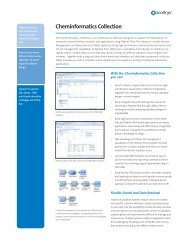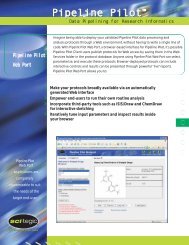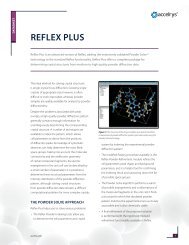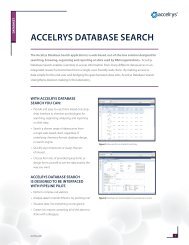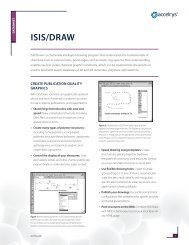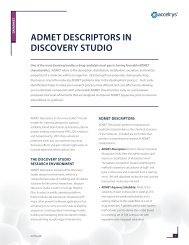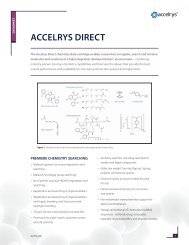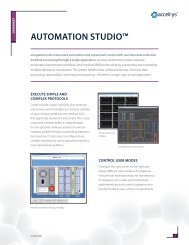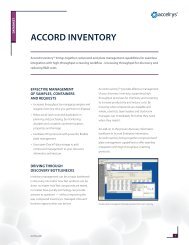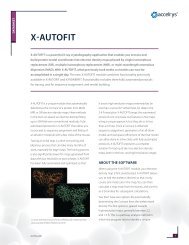Create successful ePaper yourself
Turn your PDF publications into a flip-book with our unique Google optimized e-Paper software.
DATASHEET<br />
<strong>NMR</strong> CasteP<br />
<strong>NMR</strong> CasteP predicts key magnetic resonance properties of molecules and solid state materials<br />
from first principles. Based on density functional theory (DFT), <strong>NMR</strong> <strong>CASTEP</strong> enables users to<br />
compute <strong>NMR</strong> chemical shifts and electric field gradient tensors, with unprecedented accuracy.<br />
The method can be applied to compute the <strong>NMR</strong> shifts of molecules, solids, interfaces, and surfaces<br />
for a wide range of materials classes including organic molecules, ceramics, and semiconductors.<br />
First principle calculations allow researchers to investigate the nature and origin of the magnetic<br />
resonance properties of a system without the need for any empirical parameters. <strong>NMR</strong> <strong>CASTEP</strong> is<br />
thus well suited to research problems in solid state physics, materials science, and chemistry where<br />
using computer simulations to perform virtual experiments can lead to tremendous benefits over<br />
using experimental <strong>NMR</strong> techniques alone.<br />
What does <strong>NMR</strong> CasteP do?<br />
<strong>NMR</strong> <strong>CASTEP</strong> provides a tool for predicting<br />
accurate <strong>NMR</strong> chemical shift tensors, isotropic<br />
shifts, and electric field gradients for any material<br />
with tremendous reliability: relative isotropic shifts<br />
can be predicted to within a few ppm.<br />
Developed by Cambridge University and the<br />
Université de Paris et Marie Curie, <strong>NMR</strong> <strong>CASTEP</strong> is<br />
the first ab initio <strong>NMR</strong> method to work for both<br />
molecular and periodic systems. The method<br />
can be applied equally well to simulating the<br />
<strong>NMR</strong> chemical shifts of organic molecules,<br />
organic crystals, inorganic crystals, or amorphous<br />
compounds. By incorporating relativistic effects,<br />
the implementation achieves accurate results even<br />
for heavy elements.<br />
<strong>NMR</strong> is often used as an analytical tool to aid in<br />
structure prediction. The relative complexity of<br />
solid state structures makes this a challenging<br />
task. Often, even though the general features of<br />
the crystal structure are understood, a detailed<br />
analysis of the geometry proves elusive. Using<br />
<strong>NMR</strong> <strong>CASTEP</strong> it is possible to simulate the <strong>NMR</strong><br />
spectrum for a series of related structures until<br />
a match is discovered between the computed<br />
accelrys.com<br />
and experimental results. In this way, theory<br />
complements experiment, both contributing the<br />
determination of the structure.<br />
Using computed chemical shifts,users can<br />
perform assignment of the observed <strong>NMR</strong> spectra.<br />
Comparing the accurate results of <strong>NMR</strong> <strong>CASTEP</strong><br />
with experiment makes it possible, for example, to<br />
assign chemical shifts to atoms unambiguously;<br />
to discriminate between crystal polymorphs; or<br />
to analyze the degree of disorder in crystalline<br />
minerals that lose structure due to radioactive<br />
destruction (metamict materials).<br />
<strong>NMR</strong> chemical shifts can be predicted for elements in both molecular<br />
and solid state systems. This example show the 17 O shifts for 3 different<br />
structures of SiO 2 : quartz, coesite, and stishovite.<br />
1
<strong>NMR</strong> <strong>CASTEP</strong> has been applied to a wide range of research<br />
problems including the determination of the structure of<br />
icosahedral B C; the assignment of 4 17O chemical shifts in zeolites; the<br />
comparison of glutamic acid polymorphs; and the structural analysis<br />
of aperiodic ZrSiO through analysis of the 4 29Si <strong>NMR</strong> spectrum.<br />
Published results are also available for 77Se and 125Te. For further<br />
applications, see the list of publications on the <strong>Accelrys</strong> website.<br />
the MateRials studio advaNtage<br />
<strong>NMR</strong> <strong>CASTEP</strong> is operated from within the Materials Studio’s MS<br />
Modeling software suite. MS Modeling provides a user interface<br />
that is easy-to-use and quick to learn, complying with Windows®<br />
standards. Materials Visualizer, the core MS Modeling product,<br />
runs under Windows 2000 or XP, and it offers a wide range of<br />
model building and visualization tools. You can rapidly construct<br />
models of the systems of interest, select the <strong>NMR</strong> module, and run<br />
an advanced quantum mechanical simulation.<br />
A flexible client-server architecture means that calculations can<br />
be run on Windows 2000 or XP, Red Hat Linux (Intel), SGI Irix,or<br />
HP Tru64 servers located elsewhere on your network. Results are<br />
returned to your PC,where they may be displayed and analyzed.<br />
You can easily produce high quality graphics of molecular and<br />
materials structures, molecular orbitals, electrostatic potentials, or<br />
charge densities.<br />
Output from <strong>NMR</strong> <strong>CASTEP</strong> can be instantly displayed in the MS<br />
Modeling user interface and shared with colleagues facilitating<br />
the analysis and dissemination of results<br />
hoW does <strong>NMR</strong> CasteP WoRk?<br />
<strong>NMR</strong> <strong>CASTEP</strong> has been implemented using the framework<br />
provided by the <strong>CASTEP</strong>1-3 density functional program. This uses<br />
a total energy plane-wave pseudopotential method. Combining<br />
the use of pseudopotentials and plane wave basis sets makes it<br />
extremely easy to calculate the forces on the atoms. This enables<br />
efficient optimization of ionic configurations of molecules,<br />
solids, surfaces, and interfaces. The primary reason that <strong>CASTEP</strong><br />
has become so powerful is the efficiency and accuracy of the<br />
numerical methods used to solve the equations determining the<br />
electronic state.<br />
accelrys.com<br />
DATASHEET: mATEriAlS STuDio<br />
<strong>NMR</strong> <strong>CASTEP</strong> uses the gauge-including projector augmented-wave<br />
(GIPAW) approach4 to describe the wave function in the presence<br />
of a magnetic field. Analogous to the GIAO method employed by<br />
localized basis approaches5 , the GIPAW is necessary to maintain<br />
translational invariance in the presence of a magnetic field.<br />
The chemical shift tensor, σ, is defined as the ratio between an<br />
external magnetic field, B and the magnetic field induced<br />
ext<br />
at the nucleus, B : B = -σ B . <strong>NMR</strong> <strong>CASTEP</strong> computes σ using<br />
in in ext<br />
density functional perturbation theory4 . By including relativistic<br />
effects6 the method is accurate even for heavy elements, like Te.<br />
Isotropic chemical shifts are simply the trace of σ, and these can<br />
be displayed within the MS Modeling user interface.<br />
FeatuRes aNd CaPabilities<br />
Capabilities<br />
• Computation of chemical shift tensor, isotropic chemical shift,<br />
and electric field gradients<br />
• Default nuclear quadrupole moments defined for common<br />
isotopes. Interface allows users to override default values for the<br />
study of exotic nuclei<br />
• Visualization of isotropic shifts and electric field gradients<br />
• <strong>NMR</strong> <strong>CASTEP</strong> is based on the <strong>CASTEP</strong> DFT program.<br />
For a full description of the capablilities of <strong>CASTEP</strong> visit www.<br />
accelrys.com/mstudio/ms_model ing/castep.html.<br />
system Requirements<br />
<strong>NMR</strong> <strong>CASTEP</strong> is an MS Modeling product operated within the<br />
Materials Studio® software environment running on Windows<br />
2000 or XP. Calculations are executed by the <strong>NMR</strong> <strong>CASTEP</strong> server<br />
running on Windows 2000, XP, SGI Irix, Red Hat Linux (Intel), and<br />
HP Tru64 operating systems. For detailed hardware and operating<br />
system configurations configurations visit www.accelrys.com/<br />
mstudio/sys_reqs.html<br />
To learn more about Materials Studio, go to<br />
accelrys.com/materials-studio<br />
2
ReFeReNCes:<br />
accelrys.com © 2011 <strong>Accelrys</strong> Software Inc. All brands or product names may be trademarks of their respective holders.<br />
DATASHEET: mATEriAlS STuDio<br />
1. V.Milman, B.Winkler, J.A.White, C. J. Pickard,M. C. Payne, E.V.Akhmatskaya, and R. H.Nobes, Int. J. Quant. Chem. 77 (2000) 895.<br />
2. M. C. Payne, M. P. Teter,D. C. Allan, T. A. Arias, and J.D. Joannopoulos, Rev.Mod. Phys. 64 (1992) 1045.<br />
3. M.D. Segall, P. J. D. Lindan,M. J. Probert, C. J. Pickard, P. J.Hasnip, S. J. Clark, and M. C. Payne, J. Phys.: Cond.Matt., 14 (2002) 2719.<br />
4. C. J. Pickard and F.Mauri,Phys. Rev. B 63 (2001) 245101.<br />
5. J. L.Dodds, R.McWeeny, and A. J. Sadlej, Mol. Phys. 41 (1980) 1419; K.Wolinski, J. F.Hilton, and P. Pulay, J. Am. Chem. Soc. 112<br />
(1990) 8251.<br />
6. J. R.Yates, C. J. Pickard, M. C. Payne, and F.Mauri, J. Chem. Phys. 118 (2003) 5746.<br />
DS-8016-0811<br />
3



